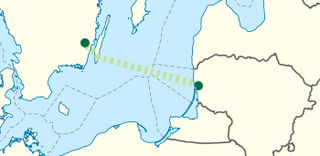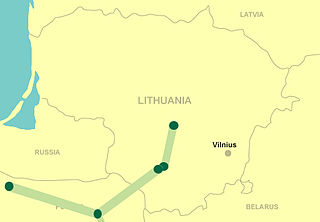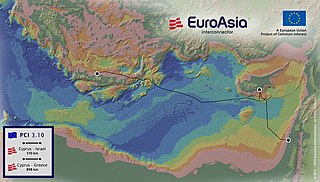Related Research Articles
The HVDC Inter-Island link is a 610 km (380 mi) long, 1200 MW high-voltage direct current (HVDC) transmission system connecting the electricity networks of the North Island and South Island of New Zealand together. It is commonly referred to as the Cook Strait cable in the media and in press releases, although the link is much longer than its Cook Strait section. The link is owned and operated by state-owned transmission company Transpower New Zealand.

The National Grid is the high-voltage electric power transmission network serving Great Britain, connecting power stations and major substations, and ensuring that electricity generated anywhere on the grid can be used to satisfy demand elsewhere. The network serves the majority of Great Britain and some of the surrounding islands. It does not cover Northern Ireland, which is part of the Irish single electricity market.

A submarine power cable is a transmission cable for carrying electric power below the surface of the water. These are called "submarine" because they usually carry electric power beneath salt water but it is also possible to use submarine power cables beneath fresh water. Examples of the latter exist that connect the mainland with large islands in the St. Lawrence River.

Estlink is a set of HVDC submarine power cables between Estonia and Finland. Estlink 1 is the first interconnection between the Baltic and Nordic electricity markets followed by Estlink 2 in 2014. The main purpose of the Estlink connection is to secure power supply in both regions to integrate the Baltic and Nordic energy markets.
The East–West Interconnector is a 500 MW high-voltage direct current submarine and subsoil power cable which connects the Irish and British electricity markets. The project was developed by the Irish national grid operator EirGrid.

National Grid, Malaysia is the high-voltage electric power transmission network in Peninsular Malaysia. It is operated and owned by Tenaga Nasional Berhad (TNB) by its Transmission Division. There are two other electrical grids in Sabah and Sarawak operated by Sabah Electricity Sdn Bhd (SESB) and Sarawak Energy Berhad (SEB) respectively.

NordBalt is a submarine power cable between Klaipėda in Lithuania and Nybro in Sweden. The purpose of the cable is to facilitate the trading of power between the Baltic and Nordic electricity markets, and to increase the supply and energy security in both markets.

LitPol Link is an electricity link between Poland and Lithuania which connects the Baltic transmission system to the synchronous grid of Continental Europe. It has a capacity of 500 MW and since 2021 it can operate in a synchronous regime.

The synchronous grid of Continental Europe is the largest synchronous electrical grid in the world. It is interconnected as a single phase-locked 50 Hz mains frequency electricity grid that supplies over 400 million customers in 24 countries, including most of the European Union. In 2009, 667 GW of production capacity was connected to the grid, providing approximately 80 GW of operating reserve margin. The transmission system operators operating this grid formed the Union for the Coordination of Transmission of Electricity (UCTE), now part of the European Network of Transmission System Operators for Electricity (ENTSO-E).
TenneT is a transmission system operator in the Netherlands and in a large part of Germany.
Energinet is the Danish national transmission system operator for electricity and natural gas. It is an independent public enterprise owned by the Danish state under the Ministry of Climate and Energy. Energinet has some 1150 employees, and its headquarters are located in Erritsø near Fredericia in Jutland. The gas division is located in Ballerup near Copenhagen.
The Great Belt power link, also known as the Great Belt electricity link, is a high-voltage direct-current interconnection across the Great Belt between Funen and Zealand connecting two power transmission systems in Denmark.
BritNed is a 1,000 MW high-voltage direct-current (HVDC) submarine power cable between the Isle of Grain in Kent, the United Kingdom; and Maasvlakte in Rotterdam, the Netherlands.

As of 2019, renewable energy in Morocco covered 35% of the country’s electricity needs.

The North Sea Link is a 1,400 MW high-voltage direct current submarine power cable between Norway and the United Kingdom.

Denmark's western electrical grid is part of the Synchronous grid of Continental Europe whereas the eastern part is connected to the Synchronous grid of Northern Europe via Sweden.

The EuroAsia Interconnector is a HVDC interconnector between the Greek, Cypriot, and Israeli power grids via the world's longest submarine power cable. Connecting Kofinou, Cyprus to Hadera, Israel and Korakias, Crete, Greece the EuroAsia Interconnector is a major Project of Common Interest of the European Union and a priority Electricity Highway Interconnector Project, as an energy highway bridging Asia and Europe. Regulatory approval of electricity interconnection between Cyprus and Greece was completed on October 10, 2017.

Solar power in Morocco is enabled by the country having one of the highest rates of solar insolation among other countries— about 3,000 hours per year of sunshine but up to 3,600 hours in the desert. Morocco has launched one of the world’s largest solar energy projects costing an estimated $9 billion. The aim of the project was to create 2,000 megawatts of solar generation capacity by 2020. The Moroccan Agency for Solar Energy (MASEN), a public-private venture, was established to lead the project. The first plant, Ouarzazate Solar Power Station, was commissioned in 2016.
Viking Link is a 1,400 MW HVDC submarine power cable under construction between the United Kingdom and Denmark.
Gridlink Interconnector is a proposed submarine power cable between England and France. The 1,400 MW HVDC connector would link Kingsnorth National Grid substation in north Kent, England, with RTE Warande substation in Bourbourg (Nord) near Dunkirk in northern France.